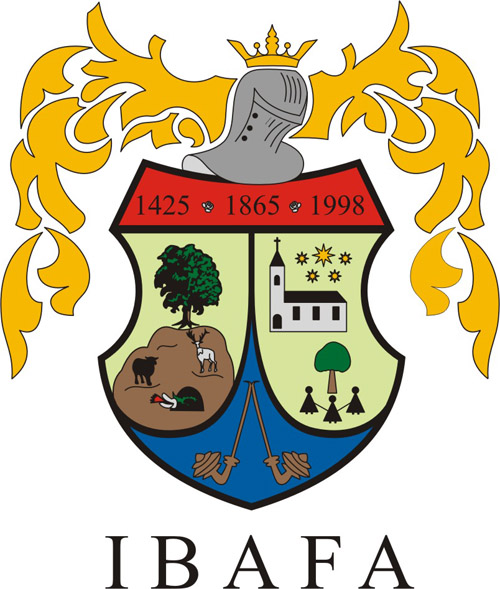
(Baranya megye)
A címerpajzs Kossuth címer formázatú.
A címerpajzs fölött az anjou korona látható, egy rostélyos páncélsisak kétoldalt aranyozott
lángnyelv díszítéssel.
A címer felső részén piros mezőben három évszám található: 1425-1865-1998.
Az 1425-ös évben említik először a falut Ibafalva néven. 1865-ben épült a templom 1998-ban adományozta a falunak a címert a pécsi Tamási család.
Az alatta levő mező három részre osztott, jobb oldalon a templom világoszöld mezőben,
fölötte öt csillag helyezkedik el. Középen egy nagy csillag, félkörben négy kisebb csillag
az egykor idetartozó községeket Korpád, Gyűrűfű, Horváthertelend, Csebény jelenti.
Alatta egy védett platánfa, melyet három stilizált emberalak áll körbe egymás kezét fogva,
ami azt jelenti, hogy három nemzetség - magyar, német és horvát - együtt él barátságban.
A címer bal oldalán kicsit sötétebb zöld mezőben, barna domb látható. A tetején egy
tölgyfa áll, alatta egy szarvas és egy juh van, amely a vidékre jellemző, vadászat és juhtartás.
Ezek alatt egy sárkány látszik egy alagútból előbújva, szájából láng tör elő, ami a pinceháti legendához fűződik.
A címer alja kék színű, amiben két pipa látható, az egyházi és az állami pipamúzeumot
jelzi.
(The County of Baranya)
The shield resembles the form of Kossuth’s coat-of-arms. Above the shield the Anjou coronet is borne, a vizored helmet adorned with a flame or on both sides.
The upper field gules bears three dates: 1425-1865-1998. 1425 is the date of the first mention of the village under the name Ibafa. The church was built in 1865, while 1998 is the date when the Tamási family of Pécs granted the coat-of-arms to the village.
The field below it is party per pale two times. The dexter field vert bears a church with five stars above it. A big star in the middle and four smaller ones below it in a semi-circle, representing the villages that belong to here: Korpád, Gyűrűfű, Horváthertelend and Csebény. Below the church a sycamore preserve, surrounded by three stylised figures holding each other’s hands, representing the fact that the three nations – Hungarian, German and Croatian – lived together in friendship.
On the sinister side in a field darker vert, a hill brown is borne with an oak tree on it. Below the hill a deer and a sheep are borne, representing hunting and sheep raising, which are typical of the area.
Below all of these a dragon is placed, coming out of its cave, flames are in his mouth, symbol of the legends of Pincehát.
The base of the shield is azure with two pipes, symbolising the church and the state pipe museums.